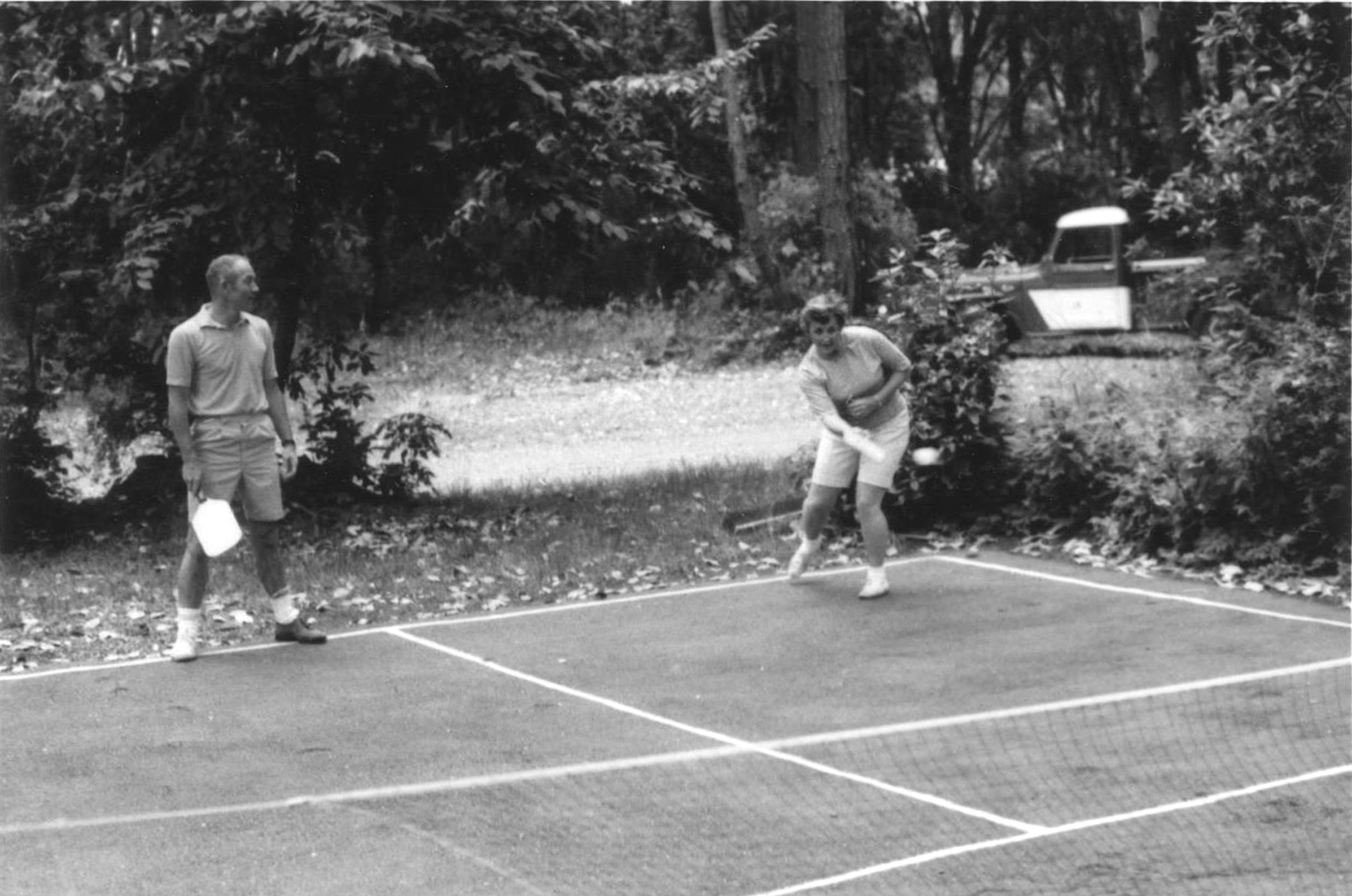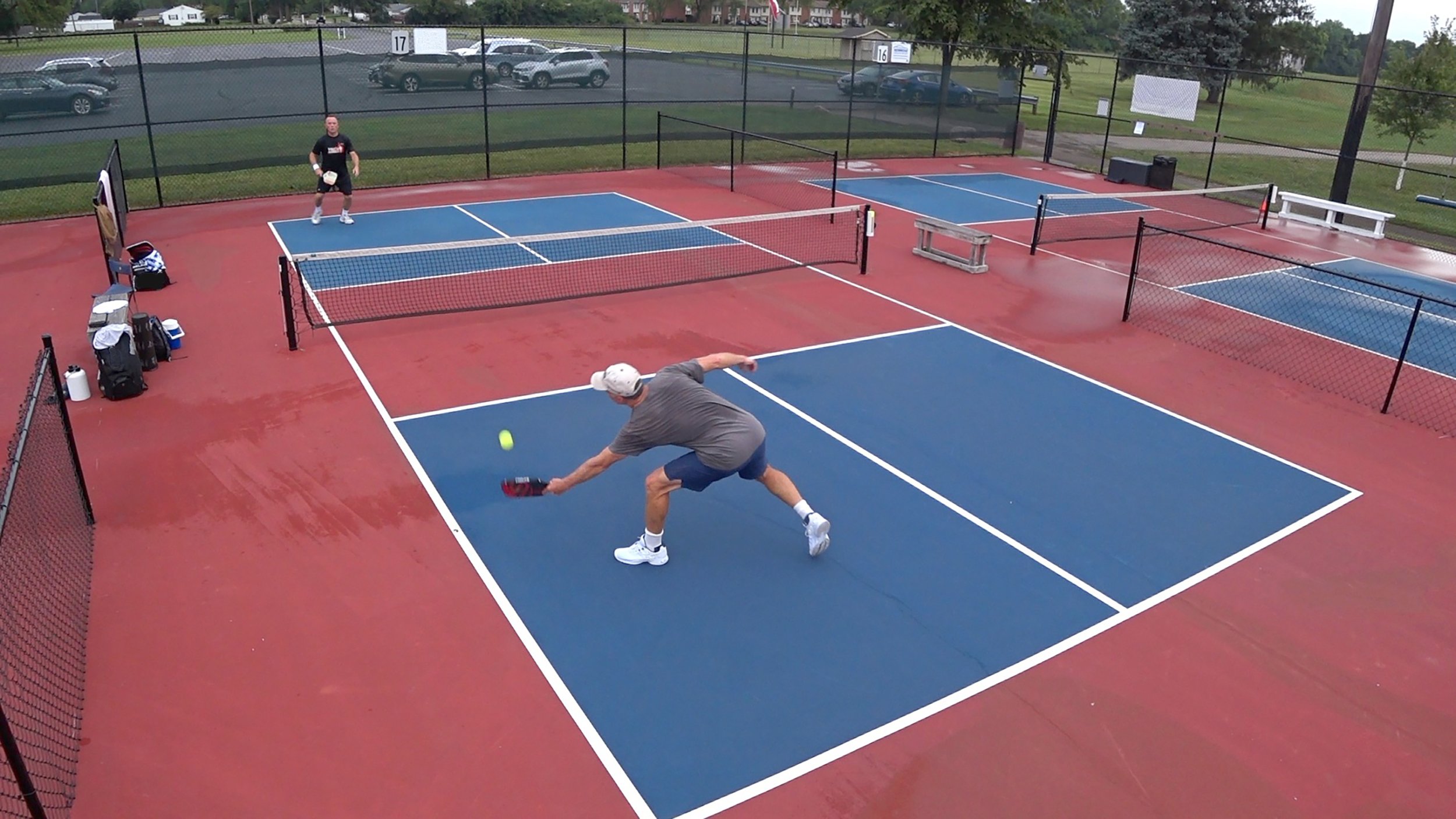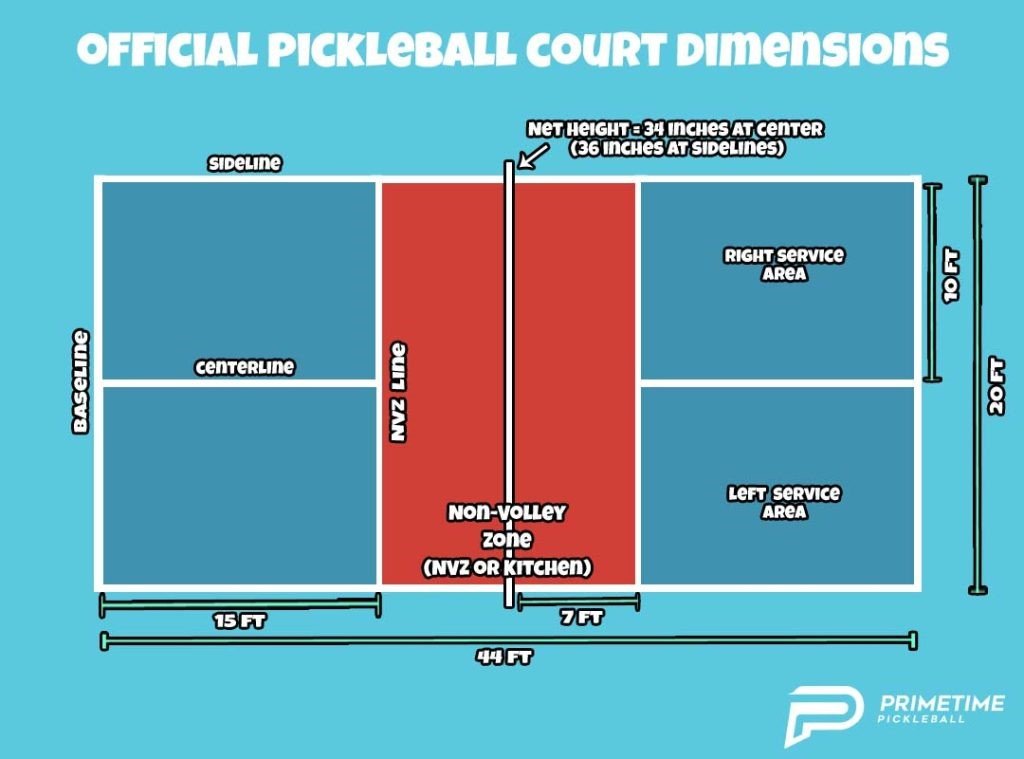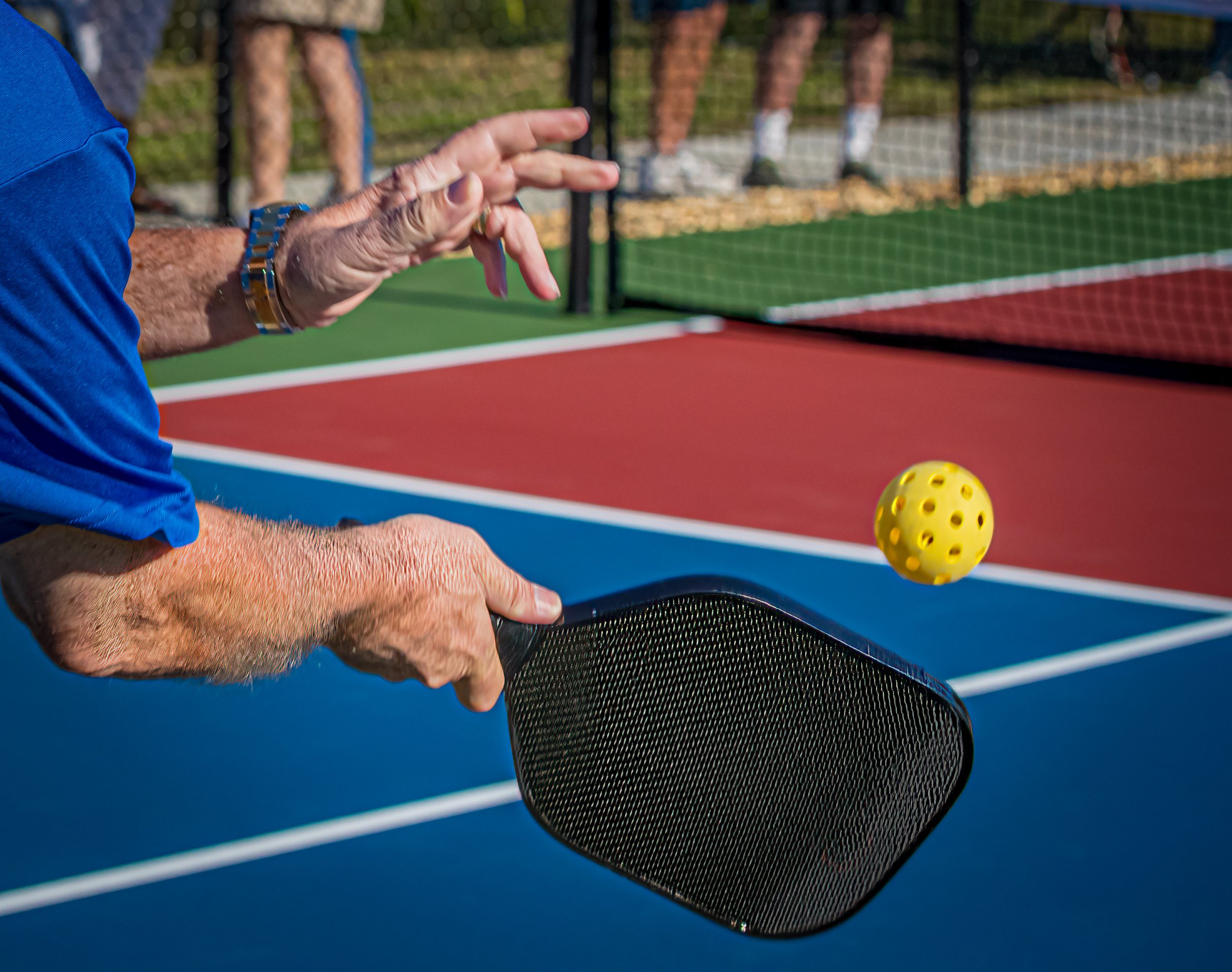Pickleball 101: Learn the Game
Pickleball in Seven Mile Beach and the surrounding area has attracted thousands to the game.
Editor’s Note: Danny Lopriore is a sports journalist with 30-plus years’ experience. Although pickleball has been dubbed the fastest-growing sport in the USA, many of us are still novices when it comes to the sport. In each issue this summer, Danny will teach us something new about the game and come September, we’ll have grown from beginners to the pro level.
Until the turn of millennium, those “in the know” about the sport of pickleball were limited to a fanatical core of players who had become consumed with the sport as a way of staying in shape and socializing around a quirky backyard game invented 60 years ago by a trio of dads looking to keep their kids busy.
Pickleball at Seven Mile Beach and the surrounding area has a shorter history, but the game has attracted thousands of devotees in the last decade and reached world-class recognition that will peak in our region this year when the Association of Pickleball Professionals hosts its New Jersey Classic tour event in Avalon Sept. 6-10.
Most people are familiar with the racquet-swinging sports of tennis, table tennis (ping pong) and badminton, all very similar in some ways. Pickleball is a combination of these games that has its origin in the most ordinary of circumstances.
According to various sources, pickleball was created in 1965 near Seattle at Bainbridge Island, Wash. Congressman Joel Pritchard and businessman Bill Bell returned to Pritchard’s home there after a round of golf and found their kids bored. That’s when they got creative.
Starting on a badminton court without a shuttlecock, the group experimented with different balls and racquets, including ping pong paddles, and lowered the 5-foot net to about 3 feet to replicate tennis. Another friend, Barney McCallum, arrived the following weekend and they came up with the rules. The game evolved over the vacation to a version of today’s pickleball, which looks a lot like playing ping pong while standing on the table.
The sport quickly became popular locally near Bainbridge Island and in 1972 Pritchard and McCallum’s son David and two others formed Pickle-Ball Inc., trademarking the name Pickle-ball. The company manufactured wooden paddles and kits to help fans “build” courts.
According to the Sports & Fitness Industry Association and the Association of Pickleball Professionals, there are currently 36.5 million players in the United States in a sport that has grown 158% in the last three years. Ages 18-34 make up 28.8% of the players and there are 10,320 courts in the U.S.
“Pickler” newsletter published a chronology in early 2020, detailing red-letter dates in the sport.
1965: The sport of pickleball was born on Bainbridge Island, Wash.
1967: The first pickleball court was constructed.
1972: Pickle-Ball Inc., a corporation, was created to protect the sport.
1975: The National Observer published an article about pickleball, which helped garner national attention for the sport.
1976: Tennis Magazine published an article about pickleball, calling the sport “America’s newest racquet sport.”
1976: The first pickleball tournament was held in Tukwila, Wash.
1984: The USAPA was created to grow the sport of pickleball nationwide. The first rulebook was also created.
1984: Arlen Paranto created the first composite pickleball paddle.
1990: Pickleball reached all 50 states in the United States.
1997: Joel Pritchard, one of the founding fathers of pickleball, died at the age of 72.
2005: The USAPA was reborn as a not-for-profit corporation. The mission remained the same, which was and is to grow the sport of pickleball in the United States.
2006: Bill Bell, one of the founding fathers, died at the age of 83.
2009: Almost 400 pickleball players from the United States (26 states) and Canada participated in the first USAPA National Tournament in Buckeye, Arizona.
2010: The International Federation of Pickleball (IFP) was created.
2019: Barney McCallum, the last of the founding fathers, died at the age of 93.
2019: Pickleball gets professional with the launch of two pro pickleball tours, the Professional Pickleball Association (PPA) and the Association of Pickleball Professionals (APP).
2021: Major League Pickleball, a unique team format for pro pickleball players, is born.
2022: Pickleball becomes the official state sport of the state of Washington.
2022: Pickleball is featured on a major broadcast network (CBS) for the first time.
As you read through the rules below, you’ll see that pickleball borrows a little from each of the three sports.
USA Pickleball rules
Pickleball is played either as doubles (two players per team) or singles; doubles is most common.
The same size playing area and rules are used for both singles and doubles.
The server’s arm must be moving in an upward arc when the ball is struck.
Paddle contact with the ball must not be made above the waist level.
The head of the paddle must not be above the highest part of the wrist at contact.
A “drop serve” is also permitted in which case none of the elements above apply.
At the time the ball is struck, the server’s feet may not touch the court or outside the imaginary extension of the sideline or centerline and at least one foot must be behind the baseline on the playing surface or the ground behind the baseline.
The serve is made diagonally crosscourt and must land within the confines of the opposite diagonal court.
Only one serve attempt is allowed per server.
Serving Sequence
Both players on the serving doubles team have the opportunity to serve and score points until they commit a fault.
If a point is scored, the server switches sides and the server initiates the next serve from the left/odd court.
As subsequent points are scored, the server continues switching back and forth until a fault is committed, and the first server loses the serve.
When the first server loses the serve, the partner then serves from their correct side of the court.
The second server continues serving until his team commits a fault and loses the serve to the opposing team.
Once the service goes to the opposition (at side out), the first serve is from the right/even court and both players on that team have the opportunity to serve and score points until their team commits two faults.
In singles, the server serves from the right/even court when his or her score is even and from the left/odd when the score is odd.
Scoring
Points are scored only by the serving team.
Games are normally played to 11 points, win by 2.
Tournament games may be to 15 or 21, win by 2.
When the serving team’s score is even (0, 2, 4, 6, 8, 10), the player who was the first server in the game for that team will be in the right/even court when serving or receiving; when odd (1, 3, 5, 7, 9) that player will be in the left/odd court when serving or receiving.
Two-Bounce Rule
When the ball is served, the receiving team must let it bounce before returning, and then the serving team must let it bounce before returning, thus two bounces.
After the ball has bounced once in each team’s court, both teams may either volley the ball (hit the ball before it bounces) or play it off a bounce (ground stroke).
The two-bounce rule eliminates the serve and volley advantage and extends rallies.
Line Calls
A ball contacting any part of any line, except the non-volley zone line on a serve, is considered “in.”
A serve contacting the non-volley zone line is short and a fault.
Non-Volley Zone
The non-volley zone is the court area within 7 feet on both sides of the net.
Volleying is prohibited within the non-volley zone. This rule prevents players from executing smashes from a position within the zone.
It is a fault if, when volleying a ball, the player steps on the non-volley zone, including the line and/or when the player’s momentum causes them or anything they are wearing or carrying to touch the non-volley zone including the associated lines.
It is a fault if, after volleying, a player is carried by momentum into or touches the non-volley zone, even if the volleyed ball is declared dead before this happens.
A player may legally be in the non-volley zone any time other than when volleying a ball.
The non-volley zone is commonly referred to as “the kitchen.”
Faults
A fault is any action that stops play because of a rule violation.
A fault by the receiving team results in a point for the serving team.
A fault by the serving team results in the server’s loss of serve or side out.
Determining Serving Team
Any fair method can be used to determine which player or team has first choice of side, service, or receive. (Example: coin flip)
Rules of pickleball
Pickleball was developed so people could have fun, so it only makes sense that the rules should remain simple.
To begin the game, the ball is served diagonally over the net. The server will stand behind the service line of the right-hand service square and hit the ball underhand and below the waist. Furthermore, the server cannot bounce the ball off the ground before hitting it. In order for the serve to be considered in play, it must clear the 7-foot no-volley area and land in the service court left of where the server is standing. The server will alternate from right to left service areas after each service point, but unlike tennis where the server gets two attempts, only one serve is allowed in pickleball. However, if the ball hits the net and lands in play, the server gets another attempt.
SCORE
A player or team can only score a point when they’re serving. The player or team continues serving until they make a fault, at which point the other team will take over the service. A team can score a point on a serve when the ball lands in the service area and the opposing team is either unable to make contact with the ball or hits it out of bounds or into the net. If the ball is successfully returned and a volley ensues, only the service team gains a point when the opposing team hits the ball out of bounds or is unable to make a return volley on a ball that drops in fair play. Each fault is worth one point to the serving team.
LINE CALL
A line call is a verbal indication of whether the ball hit within the line or outside of it. If a player shouts “out,” that means the ball has traveled beyond the line and out of fair play. In most situations, when officials are not present, the players are responsible for making objective judgments on line calls, each making the call on their respective sides.
FAULT
A fault stops play because a rule has been violated. This can range from hitting the ball into the net during a serve or a return, failure to hit the ball before it bounces twice, hitting the ball out of bounds or if a player touches the net, either with their paddle, clothes, or any part of the body. It’s also a fault if the ball strikes a player. However, if the ball hits a player’s paddle hand below the wrist, the ball is considered to be in play. Hitting a player who is out of bounds is also considered a fault.
DEAD-BALL
When a fault has occurred, the ball is deemed “dead.” Basically, any action that stops play will require declaring the ball dead. The ball is not considered dead while it is in play until the moment it bounces twice. Players might also call a ball dead when anything hinders play, such as a stray ball that comes onto the playing surface or a person who disrupts play by walking onto the court.
NON-VOLLEY ZONE
The non-volley zone is kind of like a “no man’s land.” The zone, often called “the kitchen,” extends 7 feet from the net on either side and goes out to the sidelines. Players can’t volley a ball while standing in this zone. Doing so will be considered a fault. Players will often try a drop-shot volley, which is a shot that lands as close as possible to the net, preventing the opposing team from making a volley attempt. A successful serve is one that clears the net but also clears the non-volley zone line.
TIMEOUT
Only two timeouts are allowed per game for side (team). Timeouts are limited to 60 seconds and may can only be called when the ball is not in play. An exception is for injury timeout, which must be agreed either with the referee or opposing team that an injury has taken place. Injury timeouts are limited to 15 minutes. If the injured person cannot resume play, the match goes to the opponent. There are also equipment timeouts. Should something occur during regular play that compromises clothing or equipment, a two-minute equipment time out can be called.
COURT DIMENSIONS
A pickleball court is a rectangle, 20 feet wide and 44 feet long. The dimensions are the same for singles and doubles. The total playing area is 30 feet wide and 60 feet long. The court is measured from the outside of the tapelines, not from the inside of them.
LINES & SURFACE
The lines are to be 2 inches wide and of a contrasting color to the court surface, which helps to avoid visual confusion. Generally made of tape for indoor play and paint for outdoor.
NET
When using a tennis net to play pickleball, it has to be lowered to 34 inches at center. Pickleball nets are also 36 inches high at the baselines. The net is 20 feet long, and the mesh size has to be small enough to prevent a pickleball from going through it.
BALL
Pickleballs are much like Wiffle Balls and are to be made of a durable material and have a smooth surface. The balls are to be between 2.874 inches and 2.972 inches in diameter. Official balls will weigh between .78 and .935 ounces. When dropped from a height of 78 inches, they are to bounce up from the surface to a height between 30 and 34 inches. Like a Wiffle Ball, pickleballs have holes, but no fewer than 26 and no more than 40, and there are smaller holes in a ball used for the outdoor play to minimize the effect wind will have on it.
PADDLE
There are very few restrictions on what materials can be used to make a paddle, as long as it’s rigid and made of a non-compressible material. The surface of the paddle can’t have holes or indentations in it. The surface must be smooth and feature no rough texturing. The goal is to use a paddle that doesn’t allow a player to put any extra spin on the ball, as that would be unfair. The surface of the paddle may be painted, but it can’t be so reflective that it causes glare that will disrupt the game. The paddle must be less than 17 inches long, but there is no restriction on thickness or weight.





